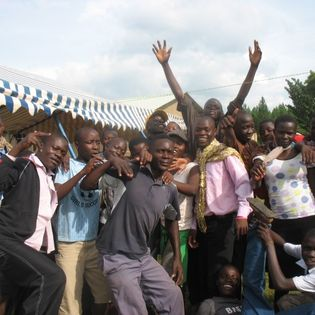I prayed and started by collecting pens and pencils from my house and my friends. Aware that education was free, I knew the kids were kept from school from a lack of scholastic material and uniforms. The first term we were able to provide scholastic material and uniforms for over 4o children
 We invited some members of the community to volunteer and help us to facilitate the mids program. Below are the first people that bought the vision and started to volunteer and have been volunteering upto now.
We invited some members of the community to volunteer and help us to facilitate the mids program. Below are the first people that bought the vision and started to volunteer and have been volunteering upto now.

By then, we were aware that we were responding to the effects of poverty and needed to develop systems that bring transformation. We believed that the best group to invest in was the youth. So that is how our Youth camps were born. Again this was a foreign idea, but we dared to risk. The first camp attracted 150 youths from the community for 5 residential days.

The children we served existed within social systems that we could not ignore. Their parents and relatives. No matter how much we were involved in eradicating their poverty, it was hard because their parents were sick, poor, and hopeless. The nearest health center from this community is 10 km, and they were losing people to very minor illnesses.
This is the far we have come.

Over time as we have sought interventions that do not only address the effects of poverty but causes that pause as hindrances to the transformation, we have had to do systemic issues that involve leadership development, advocacy, and widows ministry. We also have seen a homogenous church grow in this community.
Our Core Values
1.
Transformation
-Because in God's big story, we find the story of the community we serve. Our
part as shalom is to participate with and partner with the loving God in the
reconciliation work He is doing in this community and the holistic
transformation.
2. Collaboration- Because we
believe our efforts are unable to meet the vast needs alone. We join the larger
body of Christ and the avenues God provides through the government, networks, and
other like-minded agencies.
3. Sustainability- Because
our dream is transforming the community, we establish sustainable models that depend
on the local community’s support. We also welcome donors that are like-minded
in community transformation to bring their resources and partner with the
bigger picture.
4. Accountability-we believe
that further than Go,d we are to give an account of how we use the resources
entrusted to us. We build assessment evaluation and auditing into all our
systems. We strive to continually establish systems that help us be accountable
and develop capacity for all staff.
5. Accessibility- Because we
believe that the people in this community are made in the image of God, we make
all our programs accessible to the community as far as we can. We are here to
serve the community in a christ-like manner that is incarnational.
6. Excellence- Because we
are the hands and feet of God, we believe that we must be like our Lord in excellence.
We will do all our programs and systems with excellence.
Our Partners:
1. Our hugest support comes from great individuals who believe in our dream and give generously. The list is long.
2. Global Link Afrika (Uganda)
3. Millard Community Church (USA)
4. Busia district












Comments
Post a Comment